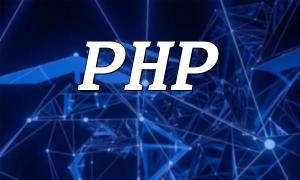With the rapid development of the internet, more and more businesses and developers are focusing on web application development and optimization. PHP, being a widely used language in web development, has become the go-to choice for many developers. To improve development efficiency and ensure maintainability of applications, adopting the MVC (Model-View-Controller) pattern is a common practice. This article shares some tips for solving common issues encountered when developing MVC with the PHP8 framework.
Before starting PHP8 framework development, selecting the right framework is crucial. Popular PHP frameworks in the market, such as Laravel, Symfony, and CodeIgniter, offer powerful tools and features that can significantly boost development efficiency. When choosing a framework, developers should consider project requirements, team familiarity, and framework extensibility to make the best decision.
In the MVC pattern, the model is responsible for data processing and business logic implementation. To maintain high maintainability, models should be lightweight and focus only on data processing and transfer, avoiding placing too much business logic in the model itself. Using object-oriented programming principles to design models can effectively improve their scalability and maintainability.
The view is responsible for presenting data to users, so it needs to be kept simple and user-friendly. Avoid including complex business logic in views, and instead, shift the logic to the controller or model. In addition, using caching technology to cache views can significantly improve website performance and reduce server load.
Controllers in MVC handle user requests and invoke the appropriate models and views. To maintain clarity and reusability in the code, controllers should adhere to the single responsibility principle and avoid overly complex logic. If controller code is repetitive or bloated, developers can consider using middleware or filters to optimize and modularize the code.
Database queries are an essential part of web applications. To improve query efficiency, developers should design the database structure properly and use techniques like indexes and foreign keys to optimize queries. Additionally, using prepared statements and bound parameters can help prevent SQL injection attacks and enhance the security of the application.
During development, errors and exceptions are inevitable. Proper error handling and logging can help developers quickly pinpoint problems and fix them. Developers can integrate error handling mechanisms within the framework, recording error messages and related data to log files for debugging and analysis.
The performance of a web application directly affects the user experience. To improve application performance, developers can adopt optimization techniques such as caching mechanisms, file compression, and asynchronous processing. Additionally, regularly monitoring application performance and adjusting the code based on the analysis results can help maintain efficient application operation.
Web applications face a variety of security threats, such as SQL injection, cross-site scripting (XSS), and cross-site request forgery (CSRF). To ensure the security of the application, developers should follow secure coding practices, such as input filtering, output escaping, and using secure validation and authorization mechanisms to prevent security vulnerabilities.
Using the PHP8 framework with MVC is an effective way to build high-quality web applications. By choosing the right framework, optimizing model design, simplifying views, improving controller and SQL query efficiency, implementing error handling and performance optimization, and enhancing security, developers can significantly improve development efficiency, enhance user experience, and ensure the stability and security of applications. Developers should make appropriate technical choices based on project needs to further improve the development experience and final results.










